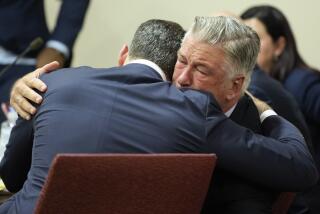PUTTING TRIAL SCENES IN ‘DEADLY FORCE’ ON TRIAL
- Share via
A trial is like an elevator that stops at every floor. Just when you think you’re really rolling, there’s a procedural snag or a conference with the judge. On and on it goes.
Or doesn’t go.
You’d never get that impression from watching trials portrayed on TV, though. During a recent stint of jury duty, I watched a defense attorney in a drunk driving case interview prospective jurors. He asked several if they watched much TV, and whether they understood that real trials were not like TV trials. All the jurors said that they understood the difference, but the attorney’s concern was an indication of TV’s role as a spinner of fables.
From “Perry Mason” to “Divorce Court,” TV has distorted the legal process, giving a false impression of trials as nonstop rides dominated by glib lawyers.
Instead of nonstop, though, there are many stops, and even the best trial attorneys are not necessarily silver-tongued. They win their cases on points of evidence and law, not lip.
A different kind of courtroom distortion occurs in “A Case of Deadly Force” coming up Wednesday at 9 p.m. on CBS. The two-hour drama stars Richard Crenna as a Boston cop-turned-high-powered lawyer, Lawrence O’Donnell, who nails the police for a wrongful shooting. The victim was killed by police who assumed he was an armed robber they were staking out.
Based on an actual case, the highly watchable story raises the ogre of excessive police force. And Crenna’s highly credible performance as the head of a family law firm overcomes most of the script deficiencies.
Yet the story’s critical trial portion is truncated, leaving the impression that the trial lasts only a couple of days. A few courtroom moves, and O’Donnell has it in the bag.
Depicting an entire trial would be impractical. But showing too little is a sham, denying viewers a complete picture as well as an opportunity to learn a lesson in jurisprudence.
That’s why Cable News Network’s telecasting of some spectacular trials has been so valuable, reviewing the raw, herky-jerky court process from start to finish. And that’s why “Inside the Jury Room,” a “Frontline” documentary scheduled for Tuesday night on PBS is so valuable--and fascinating--from another perspective.
The hourlong program eavesdrops on jurors deciding a case in Milwaukee, and it is the first time TV has been inside a jury room, according to “Frontline.”
Leroy Reed, 42, is a convicted felon on trial for illegal possession of a gun. He’s been out of prison for 11 years. He bought the gun to fulfill requirements for a mail-order private detective course.
We see brief portions of the 2 1/2-day trial. The public defender describes Reed as a well-meaning man of low intelligence who was unaware he was doing something wrong. Reed, in fact, had fingered himself by showing a policeman a receipt for his gun when asked for identification as he was hanging around the courthouse. After complying with the request to go home and get the gun, he was arrested and charged.
Reed explains on the stand why he enrolled in the mail-order private eye course. “Most of my ideas, I get from TV. Like this guy, ‘The Equalizer.’ He helps people out.”
This is not “People’s Court” or “Twelve Angry Men.”
What a compelling, instructive program, a splendid means of teaching the jury system to viewers.
We watch the jurors discuss the case and we follow their arguments, comparing their memory of testimony with videotape of actual testimony. What takes precedent, the law or their sympathy for Reed as a person? That is the question they must answer.
Although uninformed by the judge of their right to ignore the law, they lean in that direction anyway. The five women and seven men initially vote 9-3 for acquittal. Later the vote is 11-1, and we are able to observe the holdout slowly giving ground. “I’ll go along with the unanimous verdict,” he says, “but I will never feel right about it.”
After 2 hours and 28 minutes, the jury reaches a verdict.
Perhaps unintentionally, the “Frontline” program raises questions not directly related to the charges against Reed. No one on the jury even casually mentions the issue of gun control, for example. No one questions that a slow-witted convicted felon like Reed was able to walk into a store and purchase a gun in the first place.
And what of the camera in the jury room? It is one thing to unobtrusively deploy a camera at the rear of a courtroom, quite another to bring a camera and a boom microphone into a small jury room.
Did the camera disrupt the jury? Were the jurors cognizant of it as they deliberated? Did they perform for it? (One wisecracking juror seems to be doing just that.) Did the camera put pressure on the one holdout juror to be either more resistant and thereby appear strong or be more compliant and thereby appear more cooperative?
And did the camera violate the rights of Reed, described by the court as of below-average intelligence? Was this case chosen for telecast because Reed would not have the intelligence to object?
And what about the defendant, free at last to continue his search for a meaningful occupation? Where does he go now and what is his next move? What kind of help does he get?
We watch Leroy Reed leave the courtroom a free man and walk down the hall. To where? To what?
More to Read
The complete guide to home viewing
Get Screen Gab for everything about the TV shows and streaming movies everyone’s talking about.
You may occasionally receive promotional content from the Los Angeles Times.






